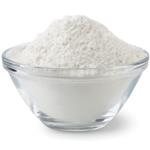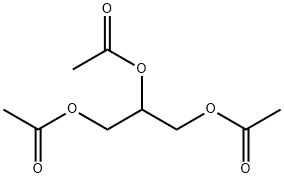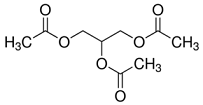| Company Name: |
Minglong (Xianning) Pharmaceutical Co., LTD
|
| Tel: |
155-7155-6913 15571556913 |
| Email: |
354024111@qq.com |
| Products Intro: |
Cas:102-76-1
ProductName:1,2,3-Propanetriol triacetate; Glycerol Triacetate, USP Grade(1.03000); TRIACETINE; Glycerol triacetate; Glyceryl triacetate; propane-1,2,3-triyl triacetate
Purity: 99
|
| Company Name: |
Beijing Minruida Technology Co., Ltd.
|
| Tel: |
010-82387566 18001021521; |
| Email: |
hr2@mreda.com.cn |
| Products Intro: |
Cas:102-76-1
ProductName:Glyceryl triacetate
Purity: AR | Package: 1L
|
| Company Name: |
Hu' nan Yunbang Pharmaceutical Co., Ltd.
|
| Tel: |
0731-85561037 15386497078 |
| Email: |
yunbang@yunbangapi.com |
| Products Intro: |
Cas:102-76-1
ProductName:Glyceryl triacetate
Purity: AR,99.5% | Package: 现货;按需包装
|
- Antimony triacetate
-

- $50.00 / 25TON
-
2022-11-15
- CAS:6923-52-0
- Min. Order: 50TON
- Purity: 99%
- Supply Ability: 200
- Antimony triacetate
-

- $15.00 / 1KG
-
2021-07-02
- CAS:6923-52-0
- Min. Order: 1KG
- Purity: 99%+ HPLC
- Supply Ability: Monthly supply of 1 ton
- Glyceryl triacetate
-

- $1280.00 / 1000KG
-
2020-11-19
- CAS:102-76-1
- Min. Order: 16000KG
- Purity: 99%
- Supply Ability: 50000
Related articles - triacetate is a common plasticizer
- Triacetin is a triglyceride obtained by acetylation of the three hydroxy groups of glycerol. It has fungistatic properties (ba....
- May 7,2022
|
| Product Name: | Triacetate | | Synonyms: | TRIACETIN;TRIACETIN (C2:0);Triacetyl glycerin;FEMA 2007;1,3-Diacetyloxypropan-2-yl acetate;propane-1,2,3-triyl triethanoate;Glyceryl triacetate,1,2,3-Triacetoxypropane, 1,2,3-Triacetylglycerol, Glycerol triacetate, Triacetin;Triacetin, 99%, extra pure, Ph Eur, USP, BP | | CAS: | 102-76-1 | | MF: | C9H14O6 | | MW: | 218.2 | | EINECS: | 203-051-9 | | Product Categories: | Functional Materials;Plasticizer;Polyalcohol Ethers, Esters (Plasticizer);emulsifier;food additive;Biochemicals and Reagents;Building Blocks;C8 to C9;Carbonyl Compounds;Chemical Synthesis;Esters;Glycerolipids;Lipids;Organic Building Blocks;Triacylglycerols;Pharmaceutical intermediates;API intermediate;102-76-1 | | Mol File: | 102-76-1.mol |  |
| | Triacetate Chemical Properties |
| Melting point | 3 °C(lit.) | | Boiling point | 258-260 °C(lit.) | | density | 1.16 g/mL at 25 °C(lit.) | | vapor density | 7.52 (vs air) | | vapor pressure | 0.00248 mm Hg @ 250C | | FEMA | 2007 | (TRI-)ACETIN | | refractive index | n25/D 1.429-1.431(lit.) | | Fp | 300 °F | | storage temp. | Sealed in dry,Room Temperature | | solubility | Soluble in water, miscible with ethanol (96 per cent) and toluene. | | form | Liquid | | color | Clear colorless | | Odor | Characteristic odour | | PH | 5.0-6.0 (20°C, 50g/L in H2O) | | biological source | synthetic | | Odor Type | fruity | | explosive limit | 1.05%, 189°F | | Water Solubility | 64.0 g/L (20 ºC) | | Merck | 14,9589 | | JECFA Number | 920 | | BRN | 1792353 | | Dielectric constant | 7.2(20℃) | | Stability: | Stable. Incompatible with strong oxidizing agents. Combustible. | | InChIKey | URAYPUMNDPQOKB-UHFFFAOYSA-N | | LogP | 0.25 | | CAS DataBase Reference | 102-76-1(CAS DataBase Reference) | | NIST Chemistry Reference | 1,2,3-Propanetriol, triacetate(102-76-1) | | EPA Substance Registry System | Glyceryl triacetate (102-76-1) |
| Safety Statements | 23-24/25 | | WGK Germany | 1 | | RTECS | AK3675000 | | Autoignition Temperature | 809 °F | | TSCA | Yes | | HS Code | 29153930 | | Hazardous Substances Data | 102-76-1(Hazardous Substances Data) | | Toxicity | LD50 i.v. in mice: 1600 ±81 mg/kg (Wretlind) |
| | Triacetate Usage And Synthesis |
| Chemical properties | Colorless, odorless oily liquid. It is miscible with ethanol, ether, benzene, chloroform and other organic solvents, soluble in acetone, insoluble in mineral oil. Slightly soluble in water. 25 ° C in water solubility of 5.9g / 100ml.
 | | Uses |
- As a plasticizer and fragrance fixative, ink solvent, also used in medicine and dye synthesis.
- As a chromatographic fixative, solvent, toughener and fragrance fixative.
- Humectants; carrier solvents; plasticizers; it can absorb carbon dioxide from the natural gas.
- In the production of cosmetics, pharmaceuticals and dyes, plasticizers for cigarette filter rods, and so on.
- Applied in cosmetics, casting, medicine, dyes and other industries. This product is non-toxic, non-irritating.
- As the substrate for the determination of lipase, perfume fixative, solvent, gas chromatographic fixative (maximum temperature of 85 ℃, solvent: methanol, chloroform), separation of gas and aldehyde analysis.
| | Production | It can be derived from the esterification of glycerol and acetic acid. After preheating glycerol to 50-60 ° C, add acetic acid, benzene and sulfuric acid. Heat and stir for refluxing dehydration, and recycle the benzene. Then add acetic anhydride for heating of 4h. After cooling, the mixture was neutralized with 5% sodium carbonate to pH 7, and the crude layer was dried and the crude oil was dried with calcium chloride. Distill under reduced pressure, collect the 128-131 ° C (0.93 kPa) fraction, namely glycerol triacetate.
| | Content analysis | Accurately weigh about 1g of the sample, put it into a suitable pressure bottle, add 25 mL of 1mol / L. potassium hydroxide solution and 15 mL of isopropyl alcohol, add stopper, wrap with cloth and put it in a canvas bag. Put it into the water bath of 98 ℃ ± 2 ℃ for 1h, and the water level in the water bath should be slightly higher than the bottle level. Take the bottle out from the bag, cool it to room temperature in the air, unfold the cloth and stopper to release the residual pressure in the bottle, and then remove the cloth. Add 6 to 8 drops of phenolphthalein test solution (TS-167), apply 0.5mol / L sulfuric acid for titration of excess alkali until the pink could just disappeared. At the same time, perform a blank test. Each mL of 0.5mol / L sulfuric acid is equivalent to 36.37 mg of glyceryl triacetate (C9H14O6).
| | Toxicity | ADI is not subject to special provisions (FAO / WHO, 2001).
GR.AS (FDA, § 182.1901, 2000).
LD50 3000mg / kg (rat, oral).
| | Description | § 184.1901(a) Triacetin (C8H14O6), also known as 1,2,3-propanetriol
triacetate or glyceryl triacetate, is the triester of glycerin and acetic
acid. Triacetin can be prepared by heating glycerin with acetic
anhydride alone or in the presence of finely divided potassium
hydrogen sulfate. It can also be prepared by the reaction of oxygen
with a liquid-phase mixture of allyl acetate and acetic acid using
a bromide salt as a catalyst. | | Chemical Properties | Colorless liquid; slight fatty odor; bitter
taste. Slightly soluble in water;
very soluble in alcohol, ether, and other organic
solvents. Combustible. | | Chemical Properties | Triacetin has a very faint, fruity odor. It has a mild, sweet taste that is bitter above 0.05%. | | Chemical Properties | Triacetin is a colorless, viscous liquid with a slightly fatty odor. | | Originator | Enzactin,Ayerst,US,1957 | | Occurrence | Reported found in papaya. | | Uses | Triacetin is a colorless, oily liquid of slight fatty odor and bitter taste. It is soluble with water and is miscible with alcohol and ether. It functions in foods as a humectant and solvent. | | Uses | As fixative in perfumery; solvent in manufacture of celluloid, photographic films. Technical triacetin (a mixture of mono-, di-, and small quantities of triacetin) as a solvent for basic dyes, particularly indulines, and tannin in dyeing. | | Uses | Triacetin, a component of cigarette filters, induced a
contact dermatitis in a worker at a cigarette manufacturers. | | Definition | ChEBI: A triglyceride obtained by acetylation of the three hydroxy groups of glycerol. It has fungistatic properties (based on release of acetic acid) and has been used in the topical treatment of minor dermatophyte infections. | | Preparation | By direct reaction of glycerol with acetic acid in the presence of Twitchell’s reagent, or in benzene solution of glycerol and
boiling acetic acid in the presence of a cationic resin (Zeo-Karb H) pretreated with dilute H2SO4. | | Production Methods | Triacetin is prepared by the esterification of glycerin with acetic
anhydride. | | Manufacturing Process | 200 grams of allyl acetate, 450 grams of glacial acetic acid and 3.71 grams of
cobaltous bromide were charged to the reactor and the mixture was heated to
100°C. Pure oxygen was then introduced into the reactor below the surface of
the liquid reaction mixture at the rate of 0.5 standard cubic feet per hour.
Initially, all of the oxygen was consumed, but after a period of time oxygen
introduced into the mixture passed through unchanged. During the course of
the reaction, a small quantity of gaseous hydrogen bromide (a total of 1.9
grams) was introduced into the reaction zone, along with the oxygen. The
reaction was allowed to continue for 6 hours following which the reaction
mixture was distilled. Essentially complete conversion of the allyl acetate took
place. A yield of 116 grams of glycerol triacetate was obtained, this being
accomplished by distilling the glycerol triacetate overhead from the reaction
mixture, at an absolute pressure of approximately 13 mm of mercury. | | Therapeutic Function | Topical antifungal | | Taste threshold values | Sweet and creamy with an oily mouthfeel. | | General Description | Triacetin is a triester of glycerin and acetic acid that occurs naturally in papaya. It is mainly used as a synthetic flavoring agent in ice-creams, nonalcoholic beverages and baked goods. | | Pharmaceutical Applications | Triacetin is mainly used as a hydrophilic plasticizer in both aqueous
and solvent-based polymeric coating of capsules, tablets, beads, and
granules; typical concentrations used are 10–35% w/w.
Triacetin is used in cosmetics, perfumery, and foods as a solvent
and as a fixative in the formulation of perfumes and flavors. | | Contact allergens | Triacetin is a component of cigarette filters, which
induced a contact dermatitis in a worker at a cigarette
manufactory. | | Clinical Use | Glyceryl triacetate (Enzactin, Fungacetin) is a colorless, oilyliquid with a slight odor and a bitter taste. The compound issoluble in water and miscible with alcohol and most organicsolvents.
The activity of triacetin is a result of the acetic acid releasedby hydrolysis of the compound by esterases presentin the skin. Acid release is a self-limiting process becausethe esterases are inhibited below pH 4. | | Safety Profile | Poison by ingestion.
Moderately toxic by intraperitoneal,
subcutaneous, and intravenous routes. An
eye irritant. Combustible when exposed to
heat, flame, or powerful oxidizers. To fight
fire, use alcohol foam, water, CO2, dry
chemical. When heated to decomposition it
emits acrid smoke and irritating fumes. | | Safety | Triacetin is used in oral pharmaceutical formulations and is
generally regarded as a relatively nontoxic and nonirritant material
at the levels employed as an excipient.
LD50 (dog, IV): 1.5 g/kg
LD50 (mouse, IP): 1.4 g/kg
LD50 (mouse, IV): 1.6 g/kg
LD50 (mouse, oral): 1.1 g/kg
LD50 (mouse, SC): 2.3 g/kg
LD50 (rabbit, IV): 0.75 g/kg
LD50 (rat, IP): 2.1 g/kg
LD50 (rat, oral): 3 g/kg
LD50 (rat, SC): 2.8 g/kg | | in vitro | Litton Bionetics, Inc. (1976) evaluated the mutagenic poten�tial of Triacetin in a plate test using Salmonella typhimurium
strains TA1535, TA1537, and TA1538 with and without metabolic activation. Test concentrations were 0.0013%, 0.00065%,
and 0.000325% and the solvent was dimethyl sulfoxide (DMSO).
A negative control (solvent) and appropriate positive controls
were used and gave expected results. Triacetin was not mutagenic with or without metabolic activation.
Unichema Chemie B.V. (1994) reported that Triacetin was
not mutagenic at 50 to 5000 μg/plate in an Ames test using S.
typhimurium strains TA1535, TA1537, TA98, and TA100 with
and without metabolic activation. | | in vivo | The mutagenic potential of Triacetin was determined using
adult Drosophila melanogaster (Efremova 1962). A dose of 0.2
to 0.3 mg Triacetin had a spontaneous mutation rate of approx�imately one mutation per 750 chromosomes. | | storage | Triacetin is stable and should be stored in a well-closed, nonmetallic
container, in a cool, dry place. | | Incompatibilities | Triacetin is incompatible with metals and may react with oxidizing
agents. Triacetin may destroy rayon fabric. | | Toxics Screening Level | The jnitial threshold screening level (ITSL) for Triacetin is 20 μg/20 m3 based on an annual averaging time. | | Regulatory Status | GRAS listed. Accepted in Europe as a food additive in certain
applications. Included in the FDA Inactive Ingredients Database
(oral capsules and tablets and gels). Included in nonparenteral
medicines licensed in the UK. Included in the Canadian List of
Acceptable Non-medicinal Ingredients. |
| | Triacetate Preparation Products And Raw materials |
|